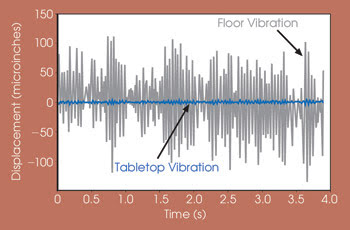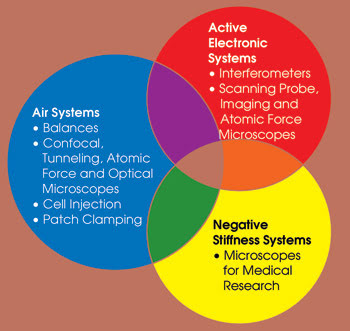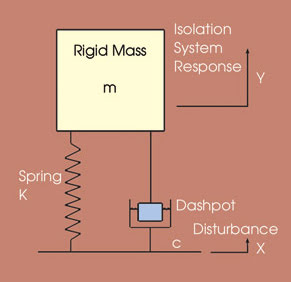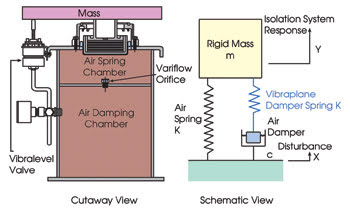To control vibration, let your application determine which system to use.
Hamid Shaidani, Kinetic Systems Inc.
Vibration-isolation workstations and related equipment are used in laboratories to improve research productivity. As our appetite for greater precision has grown, so has the array of vibration-isolation products, many of which did not exist 20 years ago. With so many choices in today’s market, it is important to match the equipment to the application.
Vibration isolation is needed because everything vibrates. Vibrations result from traffic, machinery, HVAC systems, weather, and the natural frequency of the systems or structures involved in an experiment. In buildings, most vibrations are vertical, with horizontal vibrations averaging 25 to 30 percent of the vertical. In laboratories, vibrations do not have to be obvious for performance to suffer. Day-to-day problems resulting from vibrations may include excessive signal noise, low-frequency jitter, high-resolution image blur and the appearance of line thickening. At their worst, uncontrolled vibrations can cause excessive wear and even structural damage to sensitive electromechanical and optical equipment.

Most vibrations are not noticeable to a building’s occupants, but they cannot be tolerated by equipment used in research. This graph shows typical building vibrations. The blue line shows how an active air workstation can minimize these vibrations to provide a steady tabletop.
Choosing a system
If you think you might need vibration control, you probably do. Most sensitive work benefits from vibration-isolation equipment, and installation costs are minimal compared with the costs of discovering later — after your new operation or facility is up and running — that your product is flawed or production is stalled because of unwanted vibrations.
The two most important factors to consider in choosing vibration-isolation equipment are natural frequency and isolation efficiency. The best systems achieve very low natural frequencies and attenuate all potentially damaging vibration amplitudes in the 8- to 200-Hz broadband random-vibration spectrum. However, there are many variables, so it is best to consult an expert who can help find the most appropriate equipment for your location and requirements. Some manufacturers offer on-site vibration surveys to ascertain those potentially damaging vibration amplitudes and frequencies.

Whereas vibrations can be controlled in most applications with passive or active air systems, specialized applications require active electronic or negative-stiffness equipment. The extent to which any one of the technologies will eliminate vibrations depends on the performance requirements of the particular application.
Vibration-control solutions range from relatively simple mounts and bread-boards to highly efficient air systems, active electronic systems, and negative-stiffness systems constructed with technologies and materials that take them far beyond the rubber blocks and metal springs of conventional vibration isolators. Although blocks and springs still may have their places, the increased sensitivity of the latest laboratory equipment usually makes more sophisticated vibration isolation a must.
Breadboards
Many applications do not require a highly efficient vibration-isolation workstation or, for that matter, any true vibration isolation at all. Certain tasks require only reliable flat, stable surfaces. For these jobs, economical breadboards provide a solution.
Breadboards can be used in experiments involving the injection of fluids into cells. For this application, the microscope, micromanipulator and microinjector are attached to a rigid surface to prevent any unwanted relative motion.
A larger variety of breadboards are sold now than ever before. Many are constructed with precision tooling and high-quality materials. For instance, they may be bonded under pressure with vibration-damping high-tech structural epoxies. Available in many sizes and thicknesses with or without mounting holes, some are general-purpose, whereas others stress a particular feature such as a honeycomb-type core that lightens the weight of the board without sacrificing rigidity. Breadboards are produced with both nonmagnetic and magnetic surfaces. One type has a top skin of stainless steel and provides high static stiffness. Some can be ordered with custom cutouts.
Air systems
Many types of vibration-control equipment make use of passive or active air systems. In addition to a variety of workstations and benchtop platforms, these include modular mounts, platforms and islands for large equipment.
The first technology to advance vibration isolation beyond springs and blocks was the passive air system, which relies on manually adjustable air bladders (“air springs”) replenished with a hand pump or a tank of compressed air. For a workstation or benchtop platform, passive air isolators offer high-frequency vibration isolation for less critical applications or wherever vibrations below 10 Hz are not expected. These systems require manual leveling, and when unwanted vibrations occur, they damp only the vibrations that are higher than the preset system frequency range.
Active air systems are self-leveling. Connected to a compressor or other pressurized air source, they have servo valves that automatically feed or bleed air from each isolator as needed to maintain the tabletop at a preset zero-deflection level as the load increases, decreases or is moved. Vibration isolation efficiencies for these systems can approach 99 percent for vertical and 95 percent for horizontal.
One type of active air system uses frictionless rolling-diaphragm air seals in conjunction with dual air chambers. With this design, stiffness is a function of the combined air volume of the dual chambers. Very low stiffness is needed to obtain the desired low natural frequency and thus high vertical isolation efficiency. Some systems even add pistons that enhance horizontal isolation.
Active air workstations can provide stability for confocal, atomic force or optical microscopes and for equipment used in tasks such as cell injection and patch clamping. Active air benchtop platforms enhance the performance of certain microscopes and other devices for which vibrations can be adequately controlled without a permanent table dedicated to that function.
Active air workstations are available in a wide range of payload capacities and tabletop sizes. Tabletops typically are constructed of aluminum, steel or composite with plastic, antistatic or stainless-steel laminate. Corrosion-resistant metals and layered composites can be combined to provide lightweight, rigid, highly damped surfaces. Although tabletops must be supported by low-frequency support systems, the tops themselves should have high internal natural frequencies. Tabletops can be built with honeycomb-type cores of hexagonal cells for lighter weight without sacrificing rigidity. In fact, such cores can provide natural frequencies higher than those attainable with either ribbed cast iron or a solid granite block of the same size. Thick granite tabletops also are available.
Specialized active air equipment
Small personal workstations provide economical vibration isolation in small labs and in other tight spaces. Tabletops may be constructed of steel with plastic laminate, antistatic laminate or magnetic stainless-steel laminate. Some workstations can be customized easily with accessories and typically have tabletops made of composite with plastic laminate. And there are workstations that can handle heavy, tall or moving loads and can have a variety of tabletops, including a granite slab 4 in. thick.
Variable-height workstations reduce user fatigue and back stress. These are remotely activated with a quiet electrohydraulic mechanism that allows the user to smoothly raise or lower the tabletop to maintain a posture that is ergonomically correct — a major benefit when accommodating different operators on different shifts.
Workstations for use in cleanrooms are typically constructed of welded stainless-steel tubular braces to minimize the amount of horizontal surface and to facilitate cleaning. Tabletops may be electropolished stainless-steel laminate. Completely enclosed isolation modules, stainless-steel valves and vented exhaust keep these workstations in compliance with cleanroom standards. The overall finish can be electropolish for Class 1 cleanrooms or clear passivate for Class 10 cleanrooms.
Active air benchtop platforms are available with a wide range of efficiencies and a variety of platform surfaces (stainless steel or plastic laminate, etc.), with or without mounting holes. Some models offer horizontal as well as vertical vibration control.
Also available are mounts and platforms for equipment weighing up to 20,000 lb. These make use of passive and/or active air technology, and the ones with active air provide automatic leveling. For some large equipment, a raised-floor “island” — an alternative to corner lift brackets and poured-in-place isolation pads — can be built to provide vibration isolation for a section of a room.
Active electronic equipment
Unlike air systems, active electronic systems have microprocessors that use “active feedback” to sense vibrations and provide immediate responses to eliminate them. Rapidly and automatically adjusting to different loads, this type of system dynamically isolates all six translational and rotational modes of vibration.
Applications for active electronic benchtop platforms include the support of scanning probe and imaging microscopes, and active electronic workstations are ideal for atomic force microscopes.
Active electronic benchtop platforms provide a portable vibration-isolation solution. Their tops can be ordered with or without mounting holes and can be constructed of aluminum plate, ferromagnetic stainless steel, plastic laminate or antistatic laminate.
Up to 500 times stiffer than an air table, an active electronic workstation easily can accommodate a load that is moving or has a high center of gravity. The best ones have ultralow natural frequencies (<1 Hz) and produce no low-frequency resonance. Available in a variety of load capacities and tabletops, they can actively damp vibrations from 1 to 1000 Hz, whether the vibrations originate from the building or from a piece of equipment on the platform. Isolation efficiency is especially efficient over 2 Hz, typically reaching 99 percent (40 dB) at 10 Hz. For frequencies above 1000 Hz, these workstations provide passive vibration control. For monitoring purposes, a multiplexed signal indicating vibration levels with and without isolation can be displayed on an oscilloscope.
Negative-stiffness equipment
Another type of vibration isolation workstation makes use of a stiff spring and a “negative stiffness” mechanism to provide ultralow natural frequencies, high internal structural frequencies, and excellent vertical and horizontal isolation efficiencies for static loads. Horizontal isolation is provided by beam columns connected in series with a vertical-motion isolator. For supporting microscopes in medical research and other fields, these workstations can achieve superb vibration isolation: 93 percent isolation efficiency at 2 Hz, 99 percent at 5 Hz and 99.7 percent at 10 Hz.
In the field of optics, as in other sciences, the increased demand for precision has led to optical equipment that is ultrasensitive to vibrations. These devices require very high isolation capabilities at very low frequencies (2 Hz and lower), with quick response to microdisturbances.
This performance can be achieved by vibration-isolation support systems that incorporate a combination of mechanical passive and active isolation concepts. A high-quality optical table will offer quad-tuned as well as broadband vibration damping using individual absorbers (tuned to the two lowest natural frequencies, bending and torsion, of each table) embedded in all four corners of the table. This is narrowband selective damping, provided by four frequency-tuned, mass-spring resonators dry-damped and tuned to resonate 180° out of phase with the lowest natural frequency of the table. The out-of-phase inertial forces induced in each resonator mass act to cancel or absorb the motion of the table at its natural frequency and lower the resonant amplification.

A simple vibration-isolation system can be represented as a mass, spring and dashpot. The mass (m) is infinitely rigid. The spring is weightless, and its stiffness (K) can be measured in pounds per inch. The damper, or dashpot, is also weightless, and its damping coefficient (c) typically is measured in pounds per inch per second.
Vibration isolation tips
Contrary to claims by some manufacturers, vibration-isolation equipment performs at different efficiencies depending on payload. For the best performance, the weight of your typical load should be no more than 80 percent of the equipment’s rated load capacity. For a workstation or support system, look for a manufacturer that offers equipment available in more than one load range. Some manufacturers also offer modular support systems that allow the retrofitting of workstations or optical tables to increase or decrease load capacity in the quest for greater accuracy.
Accuracy concerns also are related to ergonomics. There is no point in eliminating blur and jitter from microscope work, for example, if the operator cannot stay comfortable and alert. Good design and appropriate construction materials can make vibration-isolation equipment user-friendly.
Many accessories are available to add convenience to workstations or optical tables, including shelves, drawers, electrical outlets, monitor supports, lighting, guard rails, padded armrests, retractable casters, Faraday cages to protect sensitive operations from electromagnetic interference and other tabletop enclosures to protect against harsh manufacturing environments.

The design of the Kinetic Systems vibration-isolation system eliminates the metal springs or rubber blocks used in conventional isolator designs. Instead, it uses a frictionless rolling-diaphragm air seal to support a load-carrying piston in conjunction with dual air chambers as the spring and damping medium. The air-spring stiffness is a function of the combined air volume of the dual chambers. This provides the very low stiffness required to obtain the very low natural frequency necessary for high-efficiency vibration isolation.
Vibration-control scientists continue to integrate new ideas into their products, but experience teaches that tomorrow’s laboratory is likely to pose new vibration-isolation challenges. Ongoing research holds the promise that we can meet these challenges as they arise.
Meet the author
Hamid Shaidani is director of engineering for Kinetic Systems Inc. in Boston; e-mail: [email protected].